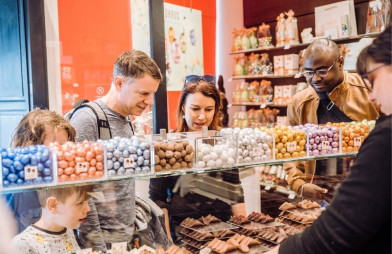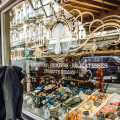
Some like discovering new beers in a local pub, some like having hands-on experience learning how to brew it. To each their own! So to help you out, here is everything you need to know about Belgian beers that will (metaphorically) quench your thirst and stimulate your taste buds. You’ll also find tips on where to stuff yourself with mussels, fries and many other Belgian culinary miracles. Hey, beer tasting is hungry work

The Brewing Monks
In the Middle Ages, abbeys were centres of knowledge for agriculture, livestock and certain crafts, including brewing beer. Back in those days, the water was contaminated and too dirty to drink, and people were dying because of waterborn diseases. That was until a monk discovered that the act of brewing beer sanitized the water and added many important nutrients into the beverage. From then on, beer became a daily beverage among Belgians. In the southern part of Europe, the monks were busy producing wine as a daily drink, because it was the beverage that matched the region’s climate. However in Belgium’s climate, winemaking was hard, so monks turned to beer instead! As a result of this, producing beer was not only a domestic activity but later on it became appreciated as an artisanal craft.

Belgian beer
During the middle ages, locals started to flavor their beer with the help of a special ingredient called gruits. They were widely available to purchase in stores throughout the country, and the most famous one is located in Bruges. Abbeys, on the other hand, used hops to brew their beers because it helped prolong the shelf life, making it easier to preserve the beer. Nowadays Belgian brewers use many different special ingredients to flavor their beer and there are more than 400 different Belgian beers, each with a unique taste and color. This is what makes Belgian beer so Belgian!

Beers to try - Kwak
A man named Pauwel Kwak once had a coaching inn on a trade route between the two Flemish cities of Ghent and Mechelen, where the mail coachers often stopped for a break. But back then there were a set of rules called the Napoleonic code which dictated how European society was to function, according to the which, the coach drivers weren’t allowed to drink with their passengers when they stopped along en route. So Pauwel Kwak came up with a brilliant idea to design a glass that would easily attach to the carriage, so the drivers could enjoy his famous dark and heavy Kwak beer!

Beers to try - Triple Karmeliet
Many beer enthusiasts call it the best Tripel in the world and if fact, Tripel Karmaliet has won endless awards. With a recipe of wheat, oats and barley originating from a Carmelite monastery in 1679, this deep golden beer undergoes in-bottle fermentation. A robust, smooth and fruity 3 grain beer with vanilla, orange and banana aromas is a Belgian favourite

Beers to try - Oude Gueuze
Oude Gueuze is known as the ‘champagne of beers’ because of its sour taste and bubbly texture. The first sip may shock you as its sharp and citrusy flavor might not be what you’re used to. However, as you keep sipping you’ll get used to it, and you might even like it! The perfect sour taste of this beer comes from the fact that its fermentation is spontaneous, meaning the brewer takes old yeast aged for three years and mixes it with young yeast, allowing them both to spontaneously ferment the beer. It’s very hard to get hold of a bottle of Oude Gueuze as its production is limited, but if stored correctly, it can keep fermenting for 20 years after bottling.

3 local bars you'll fall in love with
If you’re visiting Belgium for the first time, it could be hard to find the best bars and cafes to enjoy an authentic Belgian experience on your own. But fear no more - we’ve chosen three local bars for you that have a rich history and an eclectic beer list, so your only problem will be deciding which beer to order!

Á La Bècasse
A classic bar that locals like to go to quench their thirst is called Á La Bècasse. This ancient bar is located right at the city center but it’s hard to find as it’s hidden in a narrow passageway right next to a waffle shop. The interior is wood panelled, mirrored and a little bit aged - which is just how locals like it. Its specialty is the traditional cherry flavoured beer Kriek, brewed in an authentically old brewery using a traditional process that goes back centuries. Try their small tasting tray that has 5 different Brussels beers for 6 euros.

A La Mort Subite
A La Mort Subite is another traditional Belgian brasserie, where you can find local foods such as Croque monsieur and Croque madame to accompany your beer. The name of the bar comes from a game that was played 100 years ago, where the person who lost the game was called Mort Subite - it literally means sudden death. Although it’s ironic to name a bar with a dark word like death when all you do here is drink and have fun, it gives us a glimpse of the dark Belgian humour. Today, the fourth generation of the same family continues to serve you delicious Gueuze beers in the same establishment, and they’ve even retained the original 1928 decor.

The Saint-Géry Market Halls
A fine architectural example of 19th-century public markets in Brussels. The building was completely restored several years ago and is now a piece of permanent information and exhibition space with urban planning, heritage, and urban renewal as its central themes. These halls host live music sessions a few days a week, and the bar that’s located right at the entrance prepares some delicious Belgian snacks like blood sausages and waffles. They have over 100 different beers and comfy couches to snuggle-up on, and when it’s quieter you can even chat with locals to discover their favorite beers and where you can find other hidden bars.

The National Hangover Food: Belgian Fries
Back in the 17th century, when harsh winters arrived the River Meuse would freeze and it would be hard to catch the fish which were a staple ingredient in local dishes. Thus, the locals found a new way to feel satisfied and full, by cutting the potatoes in the shape of fish and frying them. When American servicemen arrived in Belgium at the end of the First World War, they named the fries French Fries by mistake, as in the region of Wallonie, Belgians speak French. Belgian fries are a big part of the Belgian gastronomic and cultural heritage. You can find tiny fries shops and stall on the streets of Brussels everywhere you turn.

The secret to a good frite
A good frite has to be 1 cm square, rectangular, and fried twice. The first frying is done at 150° C and the second one at 175 ° C. The result is golden fries that are crispy on the outside and melt away in your mouth. You can top it up with not only classic sauces such as ketchup and mayonnaise but also with some traditional Belgian sauces like sauce andalouse, samurai, cocktail, Bolognese, Americaine, sauce riche, sauce chasseur, and more. Mmmh, what better way to call it a night after drinking one too many beers?
Hey curious traveler, visiting Brussels soon? Hey curious traveler, visiting Brussels soon? At City Unscripted, we create personalized city experiences led by passionate locals who share Brussels’ stories in a way no guidebook can. Whether you’re seeking hidden gems or exploring iconic landmarks, your experience is flexible and designed just for you — without the rigid structure of a tour. Discover the culture, history, and character of Brussels with a host who adapts the journey to your interests, making every moment feel unique and unscripted.
Top private experiences in Brussels
We’ll pair you with the perfect host
There is no better way to see a city than with a friend who lives there. This is why we carefully match guests with their perfect host based on interested, personality and type of experience so they can discover a city beyond the tourist trail.



















